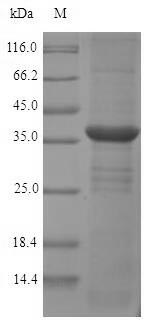To achieve the expression of the recombinant Rat Mgll protein in Yeast cells, a DNA fragment encoding the Rat Mgll protein (1-303aa) is inserted into a plasmid vector, which is then transferred to Yeast cells. After screening positive cells, they are cultured and induced to generate the Mgll protein. A N-terminal 6xHis tag is attached to the protein. Cells are lysed to collect the recombinant Rat Mgll protein, which is purified through affinity purification and then identified using SDS-PAGE and subsequent staining of the gel with Coomassie Brilliant Blue. The purity of the obtained recombinant Rat Mgll protein is over 90%.






